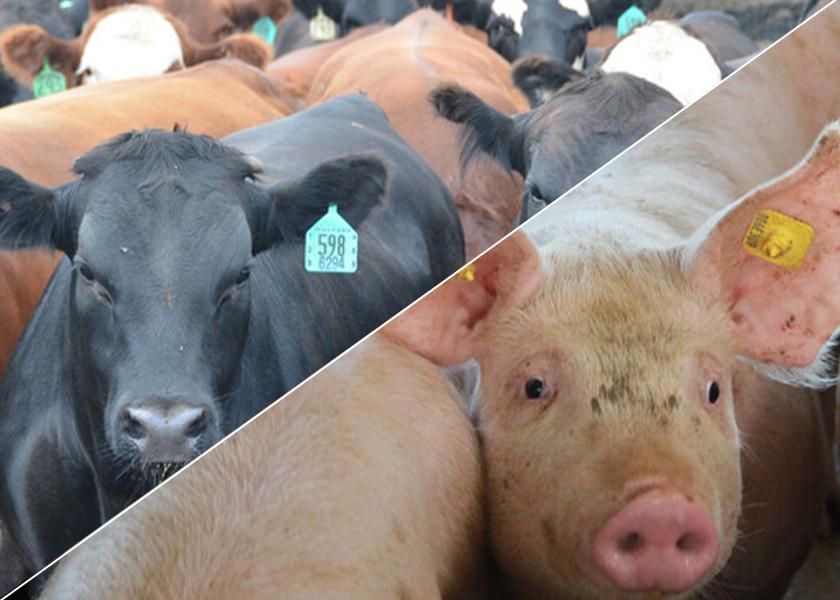Livestock Analysis | December 14, 2021

Price action: February lean hog futures fell 67.5 cents to $80.075, while December futures, which expired today, fell 10 cents to $72.175.
Fundamental analysis: Pressure on hog futures may have stemmed from expectations for ham price weakness as grocers finish buying ahead of year-end holidays. That buying will likely wrap up over the next few days and usher in the ham market’s typical late-year weakness, especially if slaughter rates follow historical precedent and reach annual high this week. But given relatively weak ham prices versus elevated levels reached earlier this year, we wonder how much downside potential the ham market may face, given prospects winter hog supplies will fall 6.0% short of year-ago levels. Early today, pork cutout values fell 12 cents to $86.91, though hams rose $3.30.
Last week’s futures strength bolstered believes hog prices have reached a seasonal low, but it’s still possible that the usual late-year weakness in cash values pulls them below lows seen in late November. Still, we doubt such a move would be to levels significantly below those seen previously. The market rebuilt some of the winter-spring premiums previously built into the 2022 hog contracts late last week. This probably reflects ideas the usual rally from the holiday season into mid-February will be exaggerated by the anticipated cut in winter hog and pork production. This may also reflect expectations for seasonally declining cattle and beef production, as well as a possible uptick in red meat demand if/when grocers start passing on to consumers the wholesale price reductions experienced during fall.
Technical analysis: Bulls seem to hold a slight advantage, since last Friday’s big surge and this week’s price action have kept February futures above pivotal support at the contract’s 40-day moving average around $79.67. A close below that level would again have bears targeting support at the sloppy head-and-shoulders bottom created over the past three months between $75.35 and $74.05. However, bulls have not been able to force a move above resistance around the contract’s 20-day moving average at $80.96. That’s backed by the recent highs at $82.70 and $84.675. A move above the latter level would have bulls targeting the October 1 high at $84.475.
What to do: Get current with feed advice.
Hedgers: You currently have all risk in the cash market.
Feed needs: You should have all soybean meal needs covered in the cash market through December. You are still hand-to-mouth on corn-for-feed needs.
Price action: February live cattle futures fell 55 cents to $138.30, while expiring December futures fell 17.5 cents to $136.775. January feeder cattle fell 95 cents to $164.575.
Fundamental analysis: Live cattle futures fell for the first day in the past three on indications a two-month rally in the cash market has ended and a slumping wholesale beef market. Cash sources reported trade in Kansas today around $138.00, which would be down close to $2.00 from last week. Packers have shortened holiday schedules the last two weeks of this month and are unlikely to bid as aggressively as they did in recent weeks, meaning cash prices likely will soften into the end of the year. USDA’s average live steer price last week fell 75 cents from the previous week, to $139.69, the first weekly decline in the past 10.
Wholesale beef remains under pressure as high retail prices pinch consumer demand. Early today, Choice cutout values fell another $1.75 to $261.47, the lowest daily average since $258.67 on April 5. Select values fell $2.79 to $250.85. Movement by midday totaled 94 loads.
Technical analysis: Bulls still hold a near-term advantage in live cattle, but a two-month-old uptrend on the daily bar chart is in jeopardy after the February contract’s drop yesterday to $136.85, the lowest intraday price in over three weeks. February futures did snap back yesterday and posted an outside day higher on the daily chart, a bullish indicator. For market bulls, upside objectives include closing February futures above solid resistance at the contract high of $141.85. The next downside technical objective for bears is closing February below solid support at $136.00.
What to do: Get current with feed advice. Short-term protective hedges for fed cattle producers may be needed if recent lows are violated.
Hedgers: Carry all risk in the cash market for now.
Feed needs: You should have all soybean meal needs covered in the cash market through December. You are still hand-to-mouth on corn-for-feed needs.






